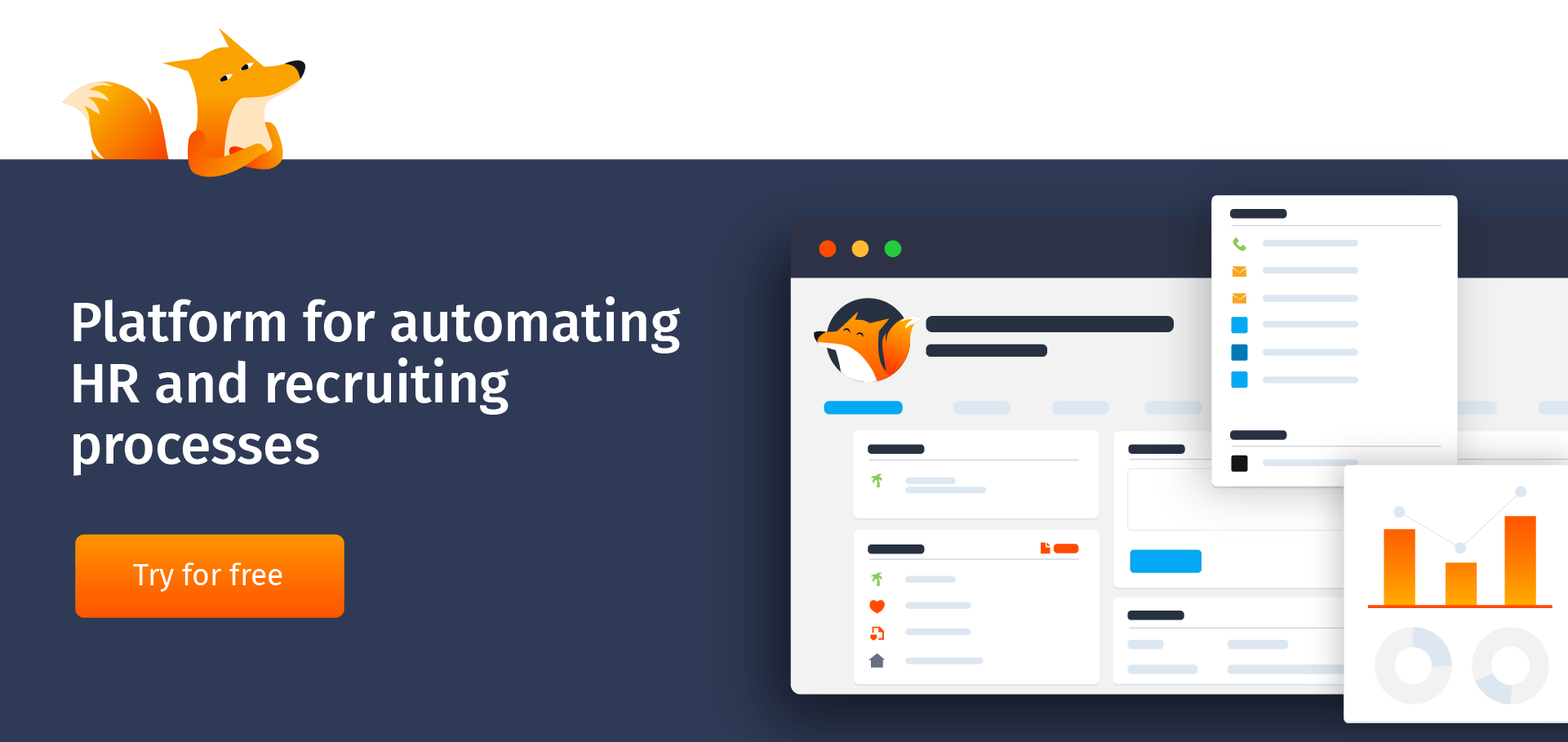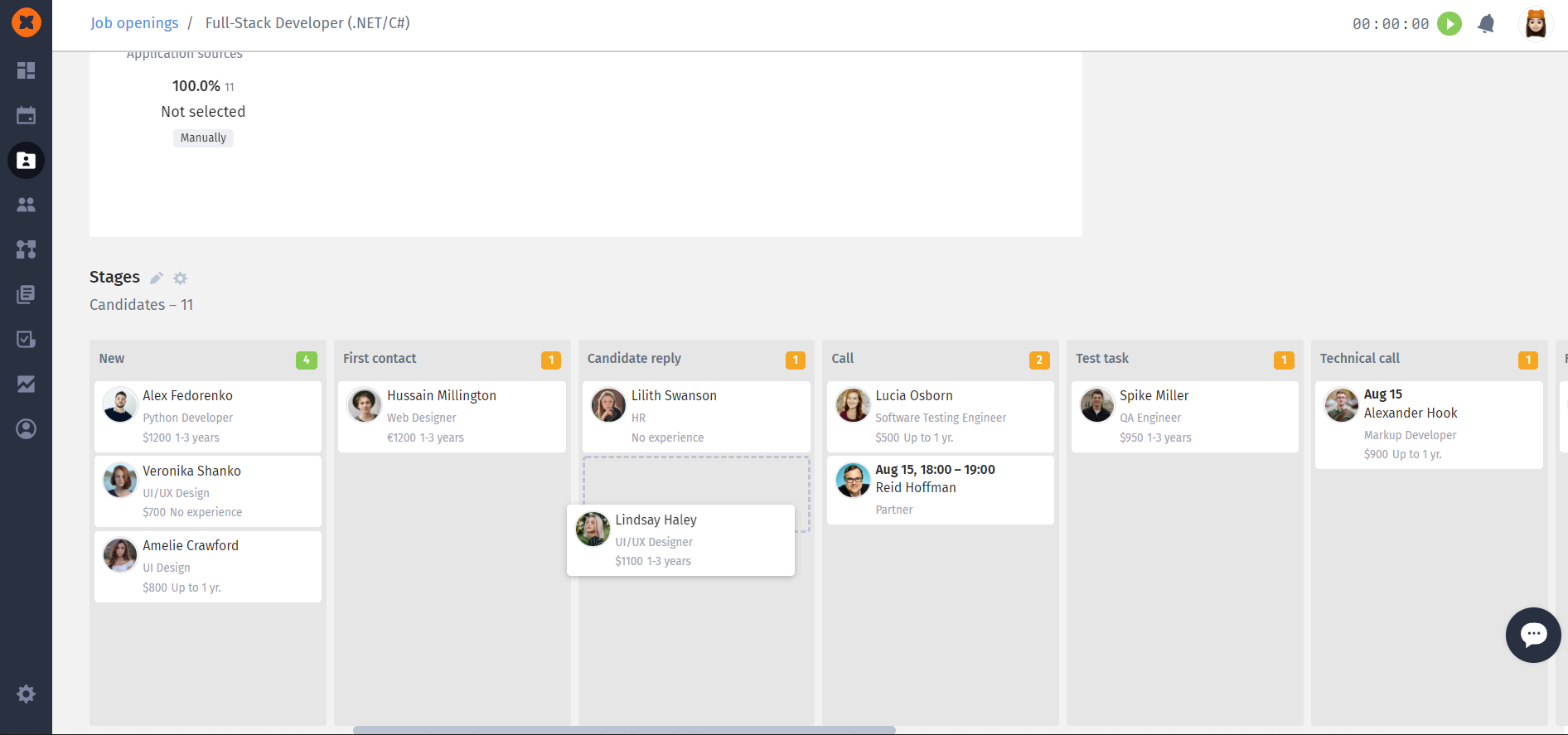Subscribe to the newsletter of articles for HR and recruiters! Be on trend with Hurma ;)
I consent to the processing and use of my personal data in accordance with the Privacy Policy and accept Terms of Service

Every company faces the challenge of recruiting on a regular basis. Even with a favorable psychological climate in the team, the natural causes of staff turnover cannot be avoided. Employees may change jobs due to health conditions, moving, other family circumstances.
The selection process is a lengthy and complex procedure, during which it is necessary to take into account corporate needs, the desired position profile, the characteristics of an already formed team, and many other factors
The successful completion of the recruitment depends on the correctness of each recruitment process stage. For example, even the preliminary preparation of the hiring process steps plays an important role for the job hiring process in the development of the company like the final reporting.
Let's take a closer look at each of the stages.
ContentImportance of the recruitment process
More about the stages of recruitment
Identification and analysis of the need in the recruitment process
Determining the profile of the candidate
Recruitment before the selection process
Acceptance of applications from candidates in the recruitment process
Pre-selection of candidates
Direct selection of personnel
Deciding on the final stage of the selection process
How to effectively manage the recruiting process
The belief that during the selection procedure only requires the candidates to put in maximum effort is a long-obsolete myth.
Representatives of the company, in particular, the manager, HRD and recruiters, should understand that not only the successful closing of the current vacancy, but also the brand of the employer as a whole depends on their actions. According to LinkedIn research, 75% of job seekers are looking for information about a company and want to know more about it before applying. Find out how your company differs from others and indicate this in all communications.
According to TalentLyft, 97% of candidates who have a good hiring experience at a company will recommend it to others. And half of them will also write praise in social networks. After all, attracting and retaining the best available talent today is literally the future of business.
At the same time, the unsatisfactory closing of even one vacancy can lead to a loss of time and money for the company. The hiring process timeline is also very important. According to a study by the US Department of Labor, the cost of a hiring error is 30% of an employee's annual salary. In addition, labor productivity or motivation may be reduced in the team, and an uncomfortable working atmosphere may be created.
The personnel selection system should guarantee that the hiring candidate will suit the organization in terms of hard & soft skills, and the new company will suit him. Only mutual inclusion will have value for cooperation.
At the same time, in no case should “skew” be allowed: experience, talent, skills, depending on the position, are just as important as emotional intelligence, personality, attitude, adaptability or social skills.
Of course, every recruiter or manager can make a mistake when closing a vacancy. It is important to remember the 7 most common mistakes that one way or another will nullify the effectiveness of even an ideal staff selection algorithm. Selection process for hiring include:

We have already mentioned that the human resource hiring practices include steps that each company successively goes through in the recruitment process. Let's move on to their consideration.

Before you start the hiring employees process, it is important to answer the question “Why are we going to start the recruitment process?”.
It is with him that the head of each personnel department should begin the passage of the stages of closing a vacancy. The expansion of the staff can never be unreasonable. The numerical growth of personnel should not take place for the sake of the extensive growth of the company, but should serve to meet its needs.
If at this stage of development the company cannot afford to hire a new employee or the effect that he should have in the team is doubtful and does not meet the set tactical goals, it is better to forget about hiring. Otherwise, you must proceed to the next step of the recruitment process.
The recruiting process is hard to imagine without creating an exhaustive candidate profile. Indeed, before declaring a search, it is necessary to decide who we are looking for. It may be important for company management that:
Of course, the specialist must, in turn, also be interested in something. His motivation is also part of the profile. Remember that the benefits of working with you must first of all be truthful. It could be:
If we do not know who we are looking for, then it will be difficult to find such a person. Only after compiling a candidate profile, you can proceed directly to the next step — the selection of applicants.
When embarking on the recruiting process, recruiters at a company have two great alternatives to finding the best talent. On the one hand, they can opt for the so-called passive recruitment, which basically consists of the company itself contacting the publicly available professional profiles that interest them the most.
During active recruitment, the company places a vacancy and job seekers apply to the company on their own.
It is traditionally believed that the process of finding and comparing applicants during passive recruitment is easier. The best result is usually obtained by combining the two methods, although it takes much more time.
If the job posted is attractive enough, it won't take long for the HR department to wait for a flood of applications. For their correct processing, you will need a reliable contact channel (recruiter or recruiters responsible for the loan process).
Of course, the application process must be transparent and fast. According to a CareerBuilder survey, 60% of candidates will not apply for a job they are interested in if the process is too long and drawn out.
Here we come to one of the most sensitive phases of the selection process. During its passage, it is reasonable to be guided by the answer to the question “By what criteria do we reduce the number of candidates in order to facilitate their more thorough evaluation?”
Based on the characteristics of the ideal profile, the least suitable applicants will be disqualified from consideration. Already at this stage, it is reasonable to use both professional testing and all kinds of personality screening. Of course, being interested in a candidate's zodiac sign is too much, but taking into account the level of emotional intelligence of a future employee is quite reasonable.
The result of the pre-screening of staff is a carefully selected pool of candidates who are expected to varying degrees of suitability for the advertised position. The next step in the selection process will be their more serious review.
It is important that each applicant receives a timely response from the company, even if it is a rejection. According to CareerBuilder, 84% of candidates expect a personal email response. But 52% of employers give less feedback than half of job seekers.
The interview is still the most common procedure in hiring. Recently, it has been losing ground, because a resume or a test task allows you to evaluate the technical side of a candidate. In the first place comes the competency interview, which allows you to assess the degree of effectiveness of the candidate in various situations.
Unlike a situational (case) interview, when a candidate is projected into a hypothetical situation and asked to model his behavior, a competency-based interview evaluates only his real experience. Properly selected interview questions will allow you to form a complete opinion about the employee, getting to know him from different angles. Moreover, the questions themselves should be behavioral, related to the competencies being tested.
The professionals responsible for evaluating applications and conducting the appropriate interviews get a very rough idea of what each applicant has to offer. However, in order to make the final decision as objective as possible, it is advisable to prepare a series of reports on the selection process, indicating the strengths and weaknesses of each candidate.
It is thanks to them that the final decision about the selection of personnel is made.
It is impossible not to recognize that automation has long and successfully influenced the labor market. Representatives of about 72% of companies admit that in the next 10 years, most recruiting processes will be automated. Thanks to this, the material costs of hiring will be reduced by up to 17%, and the time spent by recruiters by 26%.
Thanks to automated systems (in particular, ATS from HURMA), today it is possible to automate:
For example. the recruiter can view statistics on vacancies, as well as see from which search channel the candidate came.

The Recruiting Funnel contains information about the number of candidates at each stage of recruitment. Thanks to this, a recruiter or HR can analyze how many specialists reach this or that stage and draw conclusions.

All candidates are displayed on a convenient Kanban board. After entering the system, the candidate receives the status "New", and the recruiter can change his status, in accordance with the recruiting process flow.
Using a Kanban board, a recruiter can guide a candidate through all stages of the funnel from applying to a job to hiring.

The implemented recruiting analytics module and data-driven approach will help the HR department in making decisions. In particular, thanks to this it is possible to determine:
An important point that has become almost a separate trend: all this data collection requires serious legal protection of personal data. HURMA system guarantees a solution to this issue as well.
By the way, the abbreviation CRM has another meaning — Candidate Relationship Management (CRM). This is a whole system of building relationships with current and future candidates. It may include getting to know the company's policies and values, keeping employees connected and engaged.
All-in-one by HURMA system will help with solving these problems, which means that the probability that a new professional in your team will grow many times over for a long time.

I consent to the processing and use of my personal data in accordance with the Privacy Policy and accept Terms of Service
 Sources of Recruitment: Types, Efficiency and Current Trends 2022
Sources of Recruitment: Types, Efficiency and Current Trends 2022
 74 Questions for Quality Adaptation
74 Questions for Quality Adaptation